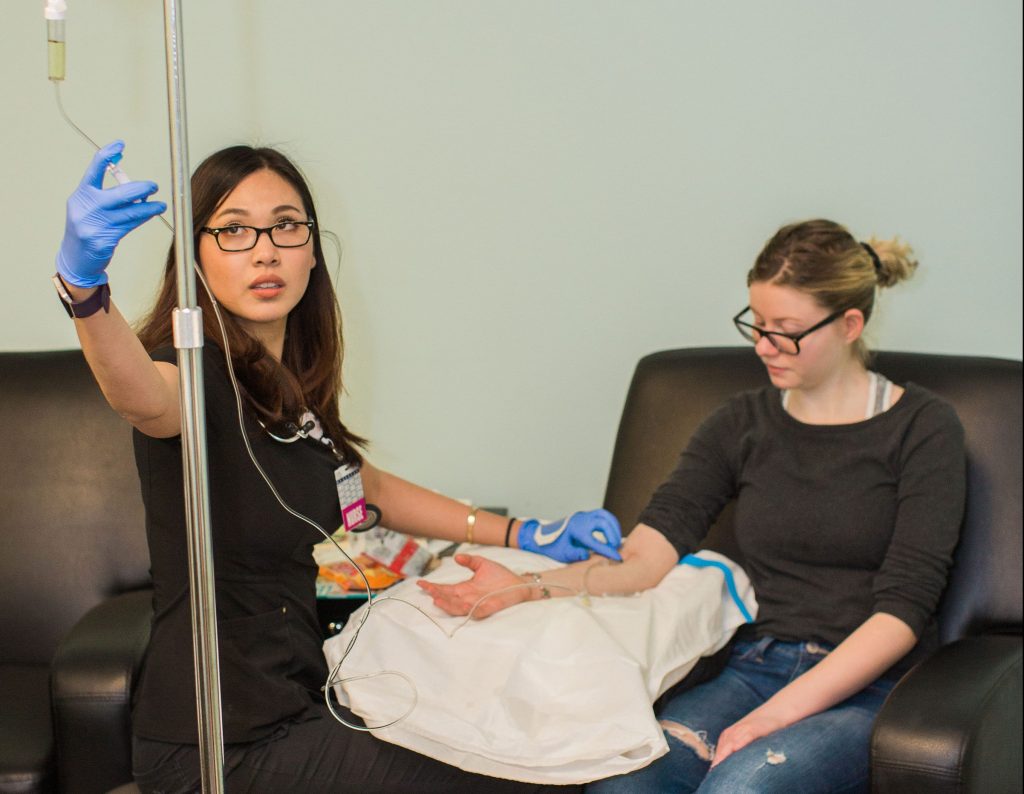WHAT IS INFUSION THERAPY AND WHEN IS IT REQUIRED?
Infusion therapy is when medication or fluids are injected through a syringe or catheter. It is a way of delivering medication that cannot be taken orally, or that requires to be dispensed at a controlled pace. In this article, we will take a closer look at what infusion therapy is, how it works, and the types of conditions it could treat.
WHAT EXACTLY IS INFUSION THERAPY?
Infusion therapy is when you receive medication through a syringe or catheter, generally intravenously (IV). Other types of infusion therapy include:
- Epidural
- Intramuscular
- Subcutaneous
Some drugs cannot be taken orally because they lose their effectiveness when exposed to your digestive system. Infusion therapy is an option when there is no comparable oral therapy or when you are unable to take oral medication.
If you have ever spent time in a hospital, you probably had an IV to make sure you stayed hydrated and to have other medications delivered quickly, if required. That is a type of infusion therapy. So is an insulin pump that releases insulin just under your skin.

Infusion therapy could also be used to deliver nutrition, as well as many types of medications, including:
- Antibiotics
- Antiemetics
- Antifungals
- Antivirals
- Biologics
- Blood factors
- Chemotherapy
- Corticosteroids
- Growth hormones
- Immunoglobulin replacement
- Immunotherapy
- Inotropic heart medications
Infusion therapy is also usually used because it permits for controlled dosing. Some types of chemotherapy, for instance, requires to be dripped slowly into the bloodstream. Other drugs require to reach the bloodstream quickly in life-and-death situations like:
- Anaphylactic shock
- Heart attack
- Poisoning
- Stroke
WHAT TYPES OF CONDITIONS IS IT USED FOR?
Chemotherapy is a frequent treatment for many types of cancer. While some chemotherapies are given orally, many must be injected through an IV. In some cases, chemotherapy drugs are administered into the spine or to a certain part of the body.
Infusion therapy permits the delivery of chemotherapy drugs directly into your bloodstream. It also allows you to receive anti-nausea and other medications without the need for more syringes.

Infusion therapy is not just for cancer, though. It is also used in the treatment of:
- Autoimmune disorders
- Congestive heart failure
- Dehydration
- Immune deficiencies
- Infections that are unresponsive to oral antibiotics
- Pain
It could deliver powerful medications for conditions like:
- Crohn’s disease
- Ulcerative colitis
- Lupus
- Psoriasis
- Psoriatic arthritis
- Rheumatoid arthritis
It could also deliver medications for a wide variety of conditions. Here are just a few:
- Blood clotting factors for hemophilia
- Immunoglobulin replacement therapy for hypergammaglobulinemia
- A “cocktail” of medications for migraine
- Corticosteroids and other medications for multiple sclerosis
- Platelet-rich plasma (PRP) for osteoarthritis
- Bisphosphonates for osteoporosis
- Insulin for type 1 diabetes
- Hyper-coagulation disorders that could cause blood clots
- Serious infections like cellulitis, pneumonia, and sepsis
WHAT CAN YOU EXPECT?
IV infusion therapy usually takes place in a clinical setting, like a primary care physician’s office, hospital, outpatient facility, or infusion center. Some types of infusion therapy could be given by healthcare providers in the home.
Each IV session means new syringe sticks. So, if you are expected to require multiple IV therapy sessions, your primary care physician might suggest alternatives to a standard IV line. Central lines could be inserted into your chest, arm, neck, or groin and remain for an extended time.
Another option is to have a port surgically placed under your skin. In future treatments, the syringe could be inserted into the port to access the vein without sticking you. The port will be surgically removed after you have completed all your treatments.
Whatever the setting, IV therapy is injected by nurses or other trained medical professionals. The procedure needs careful monitoring, so if the process is going to take more than a few minutes, there is generally some sort of control mechanism attached to the line to ensure proper delivery. Common or remote monitoring always accompanies infusion therapy.
Depending on the medication, it might be pre-prepared or prepared just prior to use.
If the infusion is expected to take a few hours in an outpatient setting, you will typically be provided a reclining chair. You could bring reading materials, blankets, or other items to help you feel comfortable.

Before starting, your nurse will perform a series of checks to verify:
- Your identity
- The right medication and the right dose
- The right time, as some medications are given at a certain time of day or for a certain length of time
- The right route, like vein, injection, or port
A syringe will be inserted into the port or a suitable vein, generally in the arm. A tube will join it to an IV bag holding the medication. The bag will be suspended so that the solution drips or flows into your bloodstream. Depending on your particular treatment, you might require multiple IV bags.
The length of each treatment depends on the medication and your certain condition. It can take 30 minutes or a few hours.
You will generally receive plenty of fluids, so do not be surprised if you require to use the bathroom. You will be able to bring the IV pole with you, but be sure to tell those monitoring you first.
Once the medication is given, the catheter will be removed.
ARE THERE ANY RISKS INVOLVED WITH INFUSION THERAPY?
Insertion of an IV syringe usually goes smoothly, but it could be challenging, particularly if you have small veins.
If you require to have many infusions, it could cause scar tissue to form over time, which might cause damage to your veins. Risks of IV therapy could include:
- Collapsed veins
- Infection
- Phlebitis
- Air embolism
Sometimes, a syringe could become dislodged, permitting the medication to get into surrounding tissues. With some medications, this could be harmful.
Other risks depend on the type of medications you are receiving. Any new medication could cause your body to react strongly. If you are going to have a reaction, it generally occurs the first time you get particular treatment.

Your primary care physician will explain the potential risks of your therapy and the signs to watch for. The signs of infusion reaction generally include:
- Cough
- Facial flushing
- Fever, chills
- Headache
- Itching
- Muscle or joint pain and solidness
- Nausea
- Rash or hives
- Shortness of breath
- Inflammation of hands, legs, ankles, or feet
- Inflammation of the tongue, lips, or eyelids
Before beginning infusion therapy, let your primary care physician know about all the medications you are taking as well as dietary and herbal supplements, as these could interact.
THE BOTTOM LINE
Infusion therapy is the injection of medication or fluids in a controlled method. It is done most usually intravenously or subcutaneously.
Since the timing could be controlled, it is used to deliver chemotherapy drugs and other medications that require to enter your system slowly. It could also be used to deliver drugs into your bloodstream quickly in the case of a life-threatening emergency.
Infusion therapy is used to give many treatments for a wide variety of conditions. It is generally injected by nurses or other trained healthcare providers, generally in a clinical setting.
Speak with your healthcare provider about the potential benefits and risks of infusion therapy, and what you could do to make it as safe and helpful as possible.
If you or anyone you know is suffering from autoimmune or neurological disorders, our expert providers at Specialty Care Clinics will take care of your health and help you recover.
Call 469-805-4561 to book an telehealth appointment for an at home check-up.

